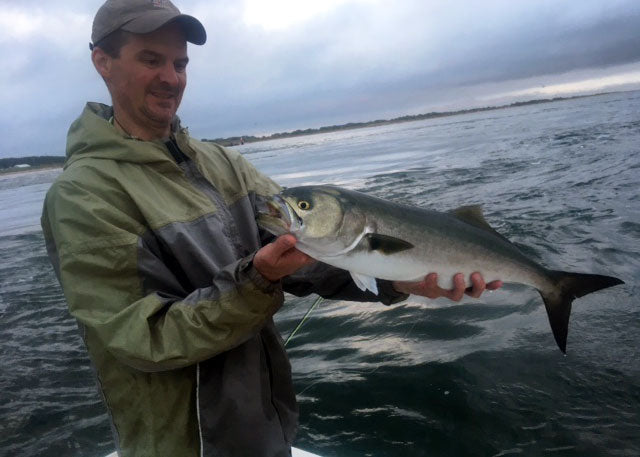Fly Fishing for Bluefish


The author holds a healthy fish that smashed a squid pattern in a rip.
Bluefish (love them or hate them) are a great saltwater species to target with a fly rod.
While they do not frequent as wide of a variety of habitats as striped bass do, they have their own eccentricities that make them unique. As an angler, playing upon these eccentricities is part of the strategy and fun.
Bluefish vs. Stripers

While there have been many comparisons made between bluefish and striped bass, particularly their respective merits as gamefish, I believe that any such exercise is rather moot.
Striped bass are like a fine wine, to be appreciated on many subtle levels and appropriately savored. They have more geographic range and are one of the first saltwater to fish to have ever been targeted with a fly, with records of such activity dating all the way back to colonial times.
3 Reasons You're Not Catching Bass
Bluefish are more like a shot of whiskey, providing a quick rush that can go straight to your head. While perhaps not as refined as stripers, they have their place and will fight harder than any striper of the same size.
So rather than choosing between bluefish and stripers, I prefer to embrace fishing for both and appreciate what each can provide over the course of the angling season.
Gearing up

When targeted with appropriate gear, bluefish can provide plenty of action and excitement.
Gearing up to fly fish for bluefish is fairly simple. Use rod weights that are appropriate for the fishing situation at hand. If you are to be fishing estuaries where the fish run small, six- and seven-weight rods are entirely appropriate. Eight- and nine-weight rods are great for flats fishing, where intermediate and floating lines are commonly used.
Fly fishing hacks: How to not forget anything on your next fishing trip
Any fishing that will require flies to sink deep will require heavier rod weights. When we fish the rips of Long Island Sound, we typically fish fast sinking lines on ten- and twelve-weight rods. A twelve-weight rod might seem like overkill, but casting ten-inch long flies with eight-hundred grain sinking lines to large bluefish in heavy current makes all aspects of the fishing easier on the angler and the fish being caught.
Fight times can be shortened with the right gear, increasing survival rates for catch-and-release fishing.
Bite guards

Never underestimate the importance of bite guards with bluefish. Their razor teeth, meant for shredding prey, can also shred standard leader material. Without a heavy mono bite guard, this Double Barrel popper would have been bitten clean off during the fight.
Bite guards are an absolute necessity when targeting bluefish.
Many anglers like wire, and it certainly has utility for this type of fishing. My personal preference is for eighty-pound test hard mono. It is fairly abrasion resistant, and has the added advantage of being less obtrusive to incidental species such as striped bass that tend to inhabit many of the same locales as blues, especially rips.
Check the bite guard after every fish caught, and when in doubt, always retie.
Fly patterns

When it comes to bluefish, you can often pick your poison with regards to fly pattern and presentation strategy. Here, Rich Strolis shows a blue that took a brightly colored fly pattern from fast-moving rip water.
Fly pattern selection for bluefish should not be complicated. Generally speaking, flies that attract a lot of attention are very good for bluefish, particularly the larger members of the species. On any given day, blues can be feeding on various small-, mid-, and large-sized baitfish, as well as squid. Other prey species can be on the menu, but these are the bulk of a blue’s diet.
Flies spanning the water column, from topwater poppers and sliders to bottom-bouncing weighted patterns, will cover your needs. Bear in mind that most weighted patterns, when fished in fast currents, will only get a few feet down in the water. This might seem like a weak use of the weight, but very often getting the fly down this short distance can drastically increase catch rate, even during topwater feeding binges. For every fish seen busting bait on the surface, there are many more feeding below, and the subsurface presentation can yield more strikes. That being said, one of the bluefish’s signature moves is to absolutely wreak havoc on a surface presentation. This is a visual and auditory phenomenon that is tough to beat.
Fly Selection and Speed of Current
Bluefish often have the reputation for being complete pushovers. There are times when just about anything moving through the water will get their attention and draw a strike, and because of this they are a great species for beginners; however, I've found numerous occasions when they can be rather selective. This has occurred under a few different conditions.
The first is when blues are daisy chaining, which is a behavior linked to spawning. Although they are less prone to strike a fly because their instincts are driven towards mating, a well-placed presentation can get results once the correct pattern is found. The right fly pattern in this situation is rarely the same thing from one time to another, so keep trying until you figure it out. This is sight fishing at its finest, and this behavior can enable an angler to target bluefish up to twenty pounds.
The Lowdown On Fly Fishing For Late Summer Low Tide Redfish
The second situation in which I have found bluefish to be picky is when they are casually grazing on acres of bait. This is not typical blitzing behavior, but rather a very slow and deliberate feeding style. My most common experience with this scenario happens when blues are feeding on bay anchovies. In this instance, fly color does not seem to matter, but fly size does. Smaller flies are readily grabbed, whereas typical large baitfish patterns have been far less successful.
These two scenarios are based on many years of observation, so don’t be afraid to experiment in your own angling situations.
Want more articles like this?
Join the Flymen Mailing List at the bottom of the page!
About Captain Mark Dysinger:
 Mark is the owner of Flyosophy Charters. He's located on the Connecticut coast and guides in the nearby waters of Long Island Sound, where he specializes in the Northeast slam of striped bass, bluefish, and false albacore. Mark is a recognized authority on fly fishing for northern pike. His works have appeared in numerous online and print publications, and he has contributed to a handful of books. Mark is a regular fixture at the Northeast fly fishing shows, where he readily shares fly tying tips and fishing strategies. His fishing activities can be followed @flyosophycharters.
Mark is the owner of Flyosophy Charters. He's located on the Connecticut coast and guides in the nearby waters of Long Island Sound, where he specializes in the Northeast slam of striped bass, bluefish, and false albacore. Mark is a recognized authority on fly fishing for northern pike. His works have appeared in numerous online and print publications, and he has contributed to a handful of books. Mark is a regular fixture at the Northeast fly fishing shows, where he readily shares fly tying tips and fishing strategies. His fishing activities can be followed @flyosophycharters.


I’ve had Pickerel bite through 30pound test tippet , but for Bluefish I’d rather try 40 pound tippet if that will handle bluefish teeth !
I fought a bluefish on a piece of mullet on spinning tackle , and I used a 25 pound steel leader , and that bluefish was so big it broke my leader , and i had to watch that very large blue swim out to sea !
Maybe I may use a double barrel popper . Mom used 30 pound test mono to catch bluefish on when she was spin fishing for them !
Hello,
I’m Clarice, an editor who passionate about dating tester. During my research of dating tester, I found your website flymenfishingcompany.com, and your content is very engaging and high-quality. That’s why I’m was wondering if you’d be interested in a content marketing collaboration with me.
I’d like to submit a well-researched article for your blog. I have brainstormed some topics which you’d be interested in. I also have a bunch of amazing resources that would link up perfectly in a well written, resource-rich, and informative article.
If interested, I could submit some topics to you for review. These topics will fit your audience and their needs.
Of course, if there’s anything specific you’d like me to focus on instead, I’m very much open to that! I’m looking forward to collaborating with you.
Best regards,
Clarice Mckinney
Editor
Very informative tips. i have read your article and i understand that, you have posted a valuable content on your website. really thank you for your great article. Also read
Blue fish are not picky eaters. When I am teaching fly tying I am always asked" What are the best flies for Bluefish" My answer is always the same . “Use the flies you don’t want any more”
Leave a comment